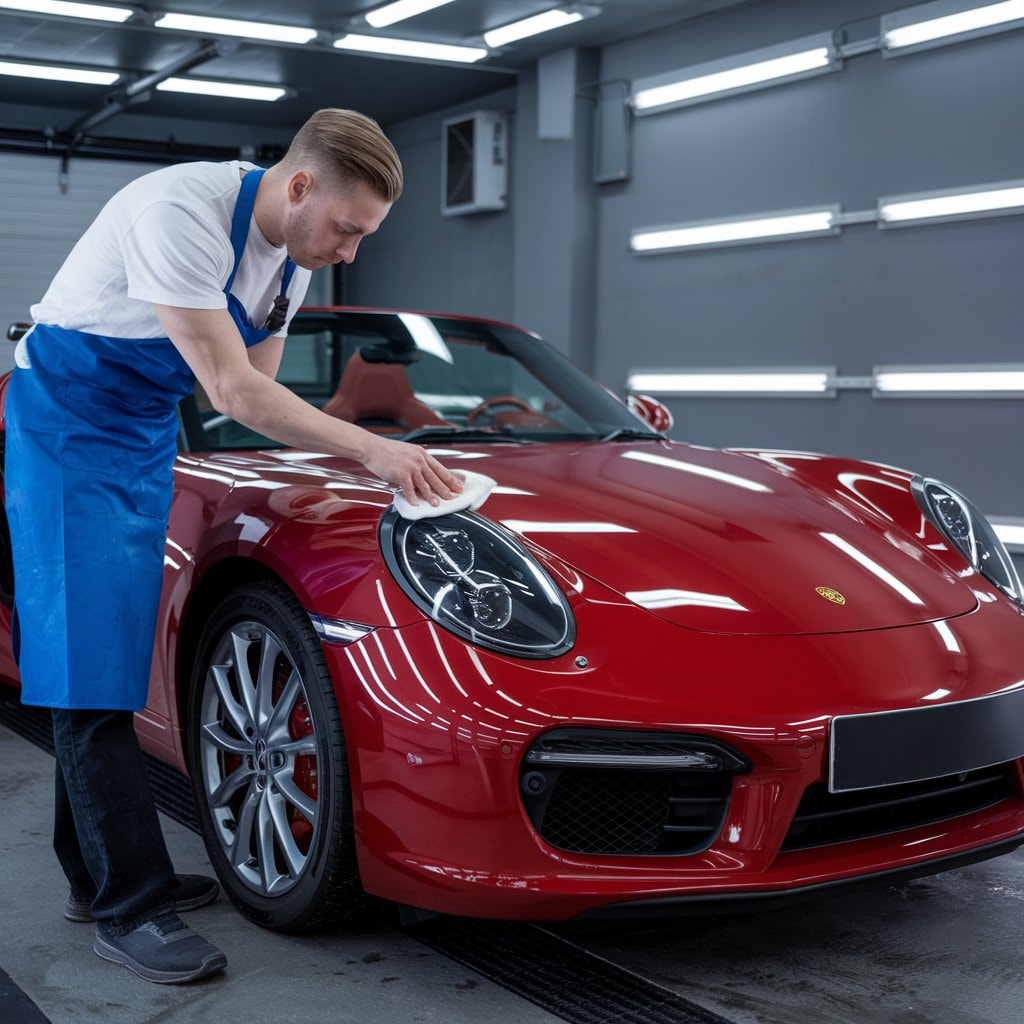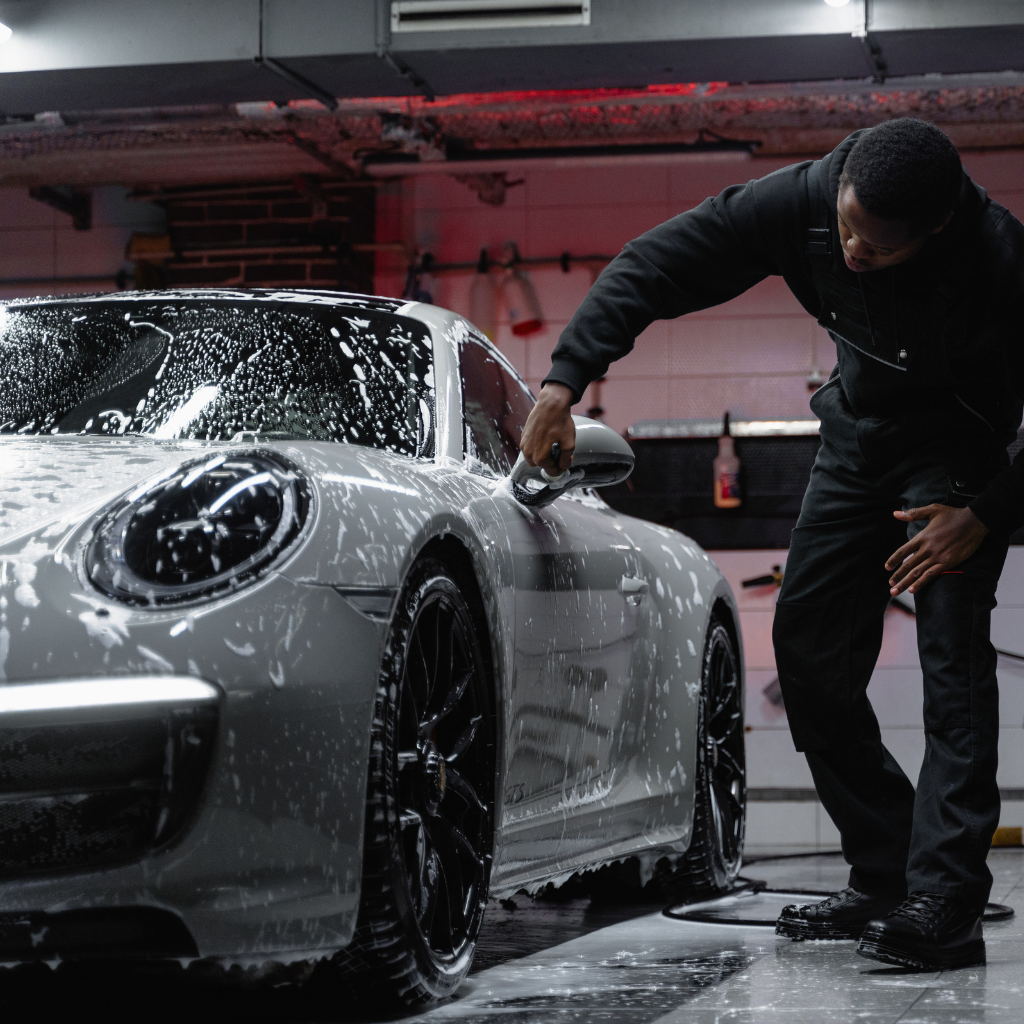To properly wax a car for a lasting shine, start by thoroughly cleaning the vehicle’s surface. Using a soft, clean microfiber towel, apply a thin, even layer of chosen wax in straight lines to avoid swirl marks. After allowing the wax to set briefly, buff the surface with a fresh microfiber towel to remove excess wax and enhance the shine. Frequent wax applications every three months guarantee maximum protection and gleam, revealing further nuances of effective car care with each waxing session.
Key Takeaways
- Clean the vehicle thoroughly before waxing to ensure optimal wax adhesion and a smooth finish.
- Apply a thin, even layer of wax using a clean microfiber towel or appropriate applicator in straight-line motions.
- Allow the wax to set briefly according to the manufacturer’s instructions before buffing.
- Use a fresh microfiber towel to buff the surface, removing excess wax and enhancing the shine.
- Repeat waxing every three months to maintain protection and shine, adjusting frequency based on vehicle usage and environmental conditions.
How to Apply Wax to Your Car
Selecting the appropriate type of wax is essential for achieving ideal protection and shine on your vehicle’s surface.
Following a precise sequence of steps guarantees the wax is applied evenly and effectively, enhancing the car’s aesthetic appeal.
Additionally, understanding and avoiding common mistakes can greatly improve the durability and outcome of the wax application.
What Type of Wax Should You Use?
Choosing the right type of wax for your car involves understanding the various formulations available and their respective benefits.
Different wax types offer unique advantages depending on the vehicle’s needs and the user’s preferences.
- Carnauba Wax: Known for its deep, rich shine and natural origin. Carnauba wax is ideal for enthusiasts looking for a high-quality finish and durability.
- Synthetic Wax: Offers ease of application and extended protection. This type of wax is effective in repelling water and contaminants.
- Paste Wax: Typically contains higher amounts of wax, providing a thicker layer of protection. It requires more effort to apply but lasts longer.
- Spray Wax: Convenient and quick to use, suitable for frequent applications and touch-ups in a spray bottle format.
When selecting a wax product, consider these types to choose the right car wax for your vehicle.
Steps to Apply Car Wax for Best Results
Preparing your vehicle for wax application is crucial to achieving the best results. To apply car wax effectively, start by using a clean microfiber towel to distribute a thin wax layer evenly across the car’s surface.
Employ circular motions to guarantee the wax adheres well and to avoid uneven spots. This technique is among the pivotal car waxing tips that enhance the wax application process.
After applying the wax, allow it to set briefly before removing the excess wax. Use a fresh, clean microfiber towel to buff the wax off, achieving a smooth finish.
Careful buffing not only enhances the shine but also guarantees that no residual wax remains on the car’s surface, thereby maximizing the protective and aesthetic benefits.
Common Mistakes When You Wax Your Car
Many car owners inadvertently compromise their vehicle’s finish by making common mistakes during the waxing process.
- Using too much wax: Excessive wax creates a build-up that is hard to remove and can leave unsightly wax residue. It is essential to use only the amount needed to cover the car thinly and evenly.
- Failing to use a proper wax applicator: Applying wax with a rough cloth or an improper tool can scratch the paint. Always use a soft, clean wax applicator designed for this purpose.
- Not spreading the wax evenly: Uneven application leads to patchy results. Verify the wax is spread uniformly across the surface.
- Applying wax in circular motions: This technique can create swirl marks. Instead, apply wax in straight lines along the length of the car.
Car Waxing Tips for Beginners
For novice car owners, understanding how to wax a car and the frequency of wax applications is essential for maintaining a vehicle’s aesthetic and protective coat.
Many beginners question whether they can effectively wax a car by hand or if specialized equipment is necessary.
Additionally, the popularity of carnauba wax among automotive enthusiasts is attributed to its superior durability and finish, making it a topic worth exploring for those new to car care.

How Often Should You Wax a Car?
Regular application of car wax is essential for any car owner seeking to preserve paint protection and enhance the vehicle’s appearance with a high shine.
Here are some guidelines:
- Frequency: Typically, wax your car every three months to keep your car shining and shielded from environmental elements.
- Climate Considerations: In harsh climates with intense sun or salt exposure, increase the frequency to guarantee a shiny surface.
- Usage Patterns: More frequent waxing might be necessary for vehicles that are used extensively or parked outdoors.
- Quality of Wax: Using high-quality car wax can sometimes extend the period between applications, adding extra shine and durability.
Can You Wax a Car by Hand?
Manually applying wax to a car is not only feasible but also recommended for those seeking meticulous control over their wax job.
To properly wax a car by hand, one should begin by making sure the car’s surface is clean and dry. Using a foam applicator, apply a small amount of wax in a thin, even layer. Move in circular motions to guarantee thorough coverage.
After the car polish has been applied, allow the wax to dry until it hazes. The timing can vary, but it is essential to verify the wax has dried completely before buffing it out with a soft microfiber cloth, revealing a protected and enhanced car paint finish.
Should You Use a Buffer or Polisher?
Deciding whether to use a buffer or polisher when waxing a car hinges on understanding their distinct advantages and appropriate applications. A buffer can enhance the finish by evenly distributing wax and minimizing swirl marks; therefore, it is essential to recognize its benefits.
Conversely, mastering the steps to operate a polisher effectively and choosing the right tool for your vehicle requires careful consideration of the car’s surface condition and the desired outcome.
Benefits of Using a Buffer on Your Car
Utilizing a buffer on a car’s surface can significantly improve the efficiency and effectiveness of the waxing process. A buffer, particularly an orbital buffer, is an essential tool in professional car detailing that enables one to achieve a superior polish and maintain the vehicle’s aesthetic appeal.
Benefits of using a buffer include:
- Even Application: Buffers distribute wax uniformly, reducing buildup and ensuring a smooth coat.
- Time Efficiency: Speeds up the waxing process compared to manual application.
- Superior Shine: Helps achieve a deeper, more lustrous shine by effectively polishing the wax layer.
- Reduced Physical Effort: Minimizes the strain on hands and arms, making it less labor-intensive than hand waxing.
Steps to Use a Polisher Effectively
Having explored the benefits of using a buffer, it becomes pertinent to understand how to effectively operate a polisher, which often gets confused with buffers but serves a distinct purpose in car detailing.
When using a polisher, first apply a quality polishing compound to the surface. This guarantees that the polisher will glide smoothly, enhancing the shine and protecting the paint.
Begin polishing in a systematic pattern, overlapping sections slightly to guarantee uniform coverage. Buff each section until the compound is nearly invisible, then wipe the area with a clean, soft cloth to reveal a glossy finish.
Regularly check your progress to maintain a consistent level of shine and smoothness across the entire surface of the car.
How to Choose the Right Buffer or Polisher for Your Car
When selecting the appropriate buffer or polisher for your car, it is crucial to evaluate the specific needs of your vehicle’s finish and your skill level.
- Type of Buffer: Choose between orbital, rotary, or dual-action buffers. Orbital buffers are best for beginners and provide a gentle wax service, while rotary buffers offer a more intense polish, ideal for removing deeper scratches.
- Power and Speed Settings: Confirm the buffer has adjustable speed settings to control the intensity of the polish, preventing damage to the clear coat when not working under direct sunlight.
- Weight and Ergonomics: A lighter buffer reduces fatigue when waxing a car by hand, especially in a detail garage.
- Pad Material: Select a pad that complements your chosen wax, confirming a perfect polish and a car shining like new.
How to Remove Wax from Your Car
Removing wax from a car requires specific tools to guarantee the vehicle’s surface is not damaged.
If wax residue is detected, certain techniques and products can be employed to effectively clean the surface without compromising the paint’s integrity.
Before reapplying fresh wax, it is essential to thoroughly prepare the car by making sure it is clean and dry to achieve the best results.
Tools Needed to Remove Wax Safely
Several specialized tools are essential for safely removing wax from a car’s surface.
Careful removal is vital to avoid scratches and guarantee the surface remains clean and free from debris. Using the right products and techniques can prevent damage, keeping the exterior in pristine condition.
- Microfiber Cloths: Soft and non-abrasive, these cloths effectively remove wax without leaving scratches.
- Damp Sponge: Ideal for loosening and lifting wax residue while minimizing the risk of scratching the paint.
- Detailing Brush: Useful for cleaning out tight spaces where wax tends to accumulate, ensuring all debris and grime is removed.

What to Do If You Find Wax Residue
Discovering stick wax residue on your car after a waxing session indicates the need for a meticulous removal process to maintain the vehicle’s aesthetic appeal and protect its paint.
Begin by inspecting the car thoroughly. Look at the paint from various angles to identify all areas with leftover wax, particularly wax around trims and edges.
Wash the vehicle with mild soap, focusing on these areas to loosen and remove any dirt that could scratch the surface during wax removal.
For stubborn wax residue, use a microfiber cloth dampened with a detailing spray designed to dissolve wax. Gently wipe the affected areas to lift the residue without harming the underlying coating.
This guarantees the surface remains shiny and ready for fresh wax, making it easy to apply evenly.
How to Prepare Your Car for a Fresh Wax Application
Once the wax residue is fully removed and the surface of your car is smooth and clean, it’s important to undertake the necessary preparations for a fresh wax application.
Proper preparation guarantees that the job is done effectively, allowing the wax to adhere better and last longer.
Here are critical steps to prepare your car:
- Confirm the Car is Dry: Completely dry your vehicle to prevent moisture from interfering with the wax application.
- Check for Grease or Dirt: Clean off any grease or dirt that could prevent the wax from adhering properly.
- Select a Shaded Area: Wax your car in a shaded area to avoid direct sun exposure, which can affect how the wax sets.
- Allow Surface to Cool: If exposed to the sun, allow the car’s surface to cool to avoid applying wax on a hot surface.
Tips for Properly Waxing a Black Car
Waxing a black car requires meticulous attention to detail to enhance its unique finish.
Special techniques are necessary to prevent swirl marks, which are more noticeable on darker surfaces.
Maintaining a deep gloss on black paint requires not only the right choice of wax but also a precise application method.
Special Care for Black Car Paint
Why should special attention be given to waxing black car paint? Black car paint is notorious for showing imperfections and dirt, making superior protection essential to keep your car looking well-maintained.
The right wax can make a significant difference, enhancing the gloss and guaranteeing the finish remains pristine. Here are key considerations for waxing a black car:
- Choose the Right Wax: Select a wax that promises superior protection and gloss enhancement specifically for black vehicles.
- Regular Application: Consistently applying wax helps in maintaining the deep black finish and protection.
- Benefits of Quality Wax: High-quality wax works to protect the paint from UV rays and contaminants.
- Application Technique: Verify the wax is applied evenly and gently to avoid scratches.
How to Avoid Swirl Marks
After addressing the importance of selecting the right wax and application techniques for black cars, it is equally important to focus on how to minimize the appearance of swirl marks during the waxing process.
Swirl marks are generally more noticeable on black cars due to their dark paint finish. To avoid these unsightly blemishes, it is vital to use a high-quality wax formulated specifically for the type of car in question.
Depending on the wax, certain application methods are recommended. Soft foam applicators are ideal as they reduce the risk of scratching the surface.
Additionally, the car must be thoroughly cleaned to remove any contaminants like bird droppings before the waxing process begins. Regular maintenance and careful application are essential to uphold the vehicle’s pristine appearance.
How to Maintain a Deep Gloss on Black Cars
Maintaining a deep gloss on black cars requires meticulous attention to the waxing process, which, if done correctly, can elevate the car’s aesthetic to show quality standards.
Achieving this involves a series of precise steps to guarantee the finish remains sleek and free from imperfections.
- Choose the Right Wax: Opt for a high-quality carnauba or polymer wax designed for dark vehicles to enhance depth and shine.
- Prep Thoroughly: Wash and dry the vehicle meticulously. Clay bar treatment is recommended to remove surface contaminants.
- Apply in Shade: Wax the car in a cool, shaded area to prevent premature drying or streaking.
- Use Microfiber Cloths: Buff with clean, soft microfiber towels to avoid scratches and enhance the shine.
Conclusion
In summary, properly waxing a car involves meticulous attention to detail and adherence to established methods. Whether utilizing a buffer or manually applying wax, it is imperative to follow each step methodically to guarantee peak results. Removing wax thoroughly and taking extra precautions with darker vehicles can further enhance the car’s shine and protection. Adopting these practices not only preserves the vehicle’s aesthetic appeal but also contributes to its longevity and value.






